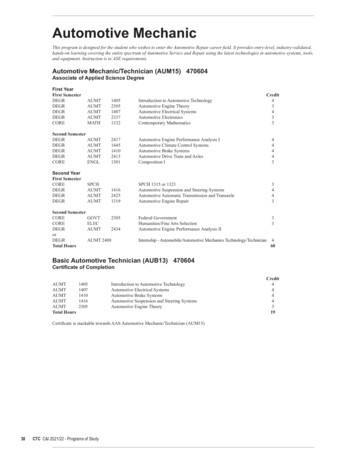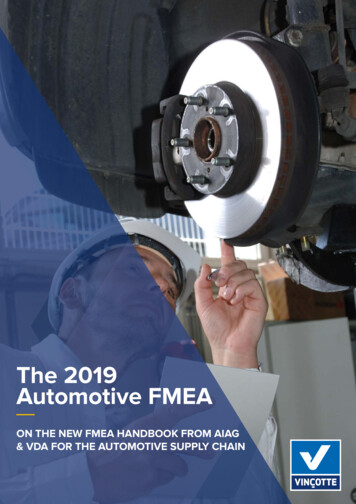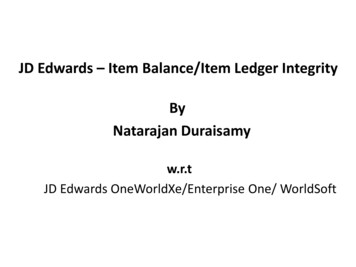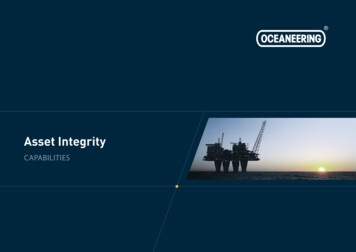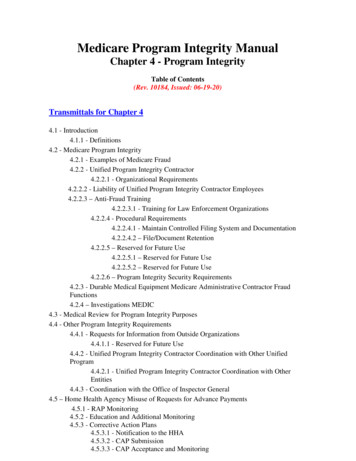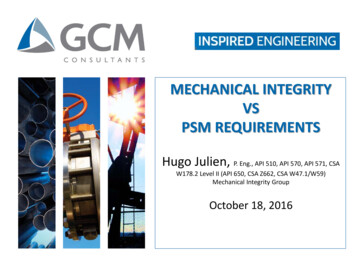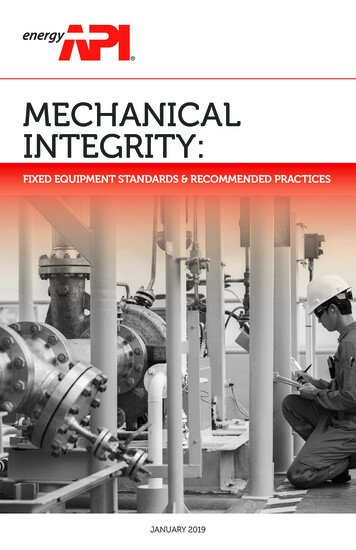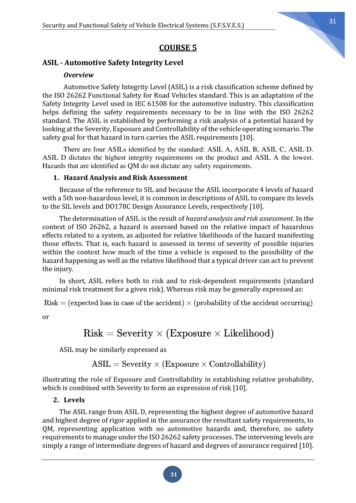
Transcription
Security and Functional Safety of Vehicle Electrical Systems (S.F.S.V.E.S.)COURSE 5ASIL - Automotive Safety Integrity LevelOverviewAutomotive Safety Integrity Level (ASIL) is a risk classification scheme defined bythe ISO 26262 Functional Safety for Road Vehicles standard. This is an adaptation of theSafety Integrity Level used in IEC 61508 for the automotive industry. This classificationhelps defining the safety requirements necessary to be in line with the ISO 26262standard. The ASIL is established by performing a risk analysis of a potential hazard bylooking at the Severity, Exposure and Controllability of the vehicle operating scenario. Thesafety goal for that hazard in turn carries the ASIL requirements [10].There are four ASILs identified by the standard: ASIL A, ASIL B, ASIL C, ASIL D.ASIL D dictates the highest integrity requirements on the product and ASIL A the lowest.Hazards that are identified as QM do not dictate any safety requirements.1. Hazard Analysis and Risk AssessmentBecause of the reference to SIL and because the ASIL incorporate 4 levels of hazardwith a 5th non-hazardous level, it is common in descriptions of ASIL to compare its levelsto the SIL levels and DO178C Design Assurance Levels, respectively [10].The determination of ASIL is the result of hazard analysis and risk assessment. In thecontext of ISO 26262, a hazard is assessed based on the relative impact of hazardouseffects related to a system, as adjusted for relative likelihoods of the hazard manifestingthose effects. That is, each hazard is assessed in terms of severity of possible injurieswithin the context how much of the time a vehicle is exposed to the possibility of thehazard happening as well as the relative likelihood that a typical driver can act to preventthe injury.In short, ASIL refers both to risk and to risk-dependent requirements (standardminimal risk treatment for a given risk). Whereas risk may be generally expressed as:orASIL may be similarly expressed asillustrating the role of Exposure and Controllability in establishing relative probability,which is combined with Severity to form an expression of risk [10].2. LevelsThe ASIL range from ASIL D, representing the highest degree of automotive hazardand highest degree of rigor applied in the assurance the resultant safety requirements, toQM, representing application with no automotive hazards and, therefore, no safetyrequirements to manage under the ISO 26262 safety processes. The intervening levels aresimply a range of intermediate degrees of hazard and degrees of assurance required [10].3131
Security and Functional Safety of Vehicle Electrical Systems (S.F.S.V.E.S.)ASIL DASIL D, an abbreviation of Automotive Safety Integrity Level D, refers to the highestclassification of initial hazard (injury risk) defined within ISO 26262 and to thatstandard’s most stringent level of safety measures to apply for avoiding an unreasonableresidual risk. In particular, ASIL D represents likely potential for severely life-threateningor fatal injury in the event of a malfunction and requires the highest level of assurancethat the dependent safety goals are sufficient and have been achieved.ASIL D is noteworthy, not only because of the elevated risk it represents, and theexceptional rigor required in development, but because automotive electrical, electronic,and software suppliers make claims that their products have been certified or otherwiseaccredited to ASIL D, ease development to ASIL D or are otherwise suitable to orsupportive of development of items to ASIL D. Any product able to comply with ASIL Drequirements would also comply with any lower level.QMReferring to "Quality Management", the level QM means that risk associated with ahazardous event is not unreasonable and does not therefore require safety measures inaccordance with ISO 26262.3. Comparison with Other Hazard Level StandardsGiven ASIL is a relatively recent development, discussions of ASIL often compare itslevels to levels defined in other well-established safety or quality management systems.In particular, the ASIL are compared to the SIL risk reduction levels defined in IEC 61508and the Design Assurance Levels used in the context of DO178C and DO254 [10].While there are some similarities, it is important to also understand the differences.IEC 61508 (SIL)ISO 26262 is an extension of IEC 61508. IEC 61508 defines a widely referencedSafety Integrity Level (SIL) classification. Unlike other functional safety standards ISO26262 does not provide normative nor informative mapping of ASIL to SIL. While the twostandards have similar processes for hazard assessment, ASIL and SIL are computed fromdifferent points. Where ASIL is a qualitative measurement of risk, SIL is quantitativelydefined as probability or frequency of dangerous failures depending on the type of safetyfunction. In the context of IEC 61508, higher risk applications require greater robustnessto dangerous failures.3232
Security and Functional Safety of Vehicle Electrical Systems (S.F.S.V.E.S.)That is, for a given Tolerable Risk, greater Risk requires more risk reduction, i.e.,smaller value for probability of dangerous failure. For a safety function operating in highdemand or continuous mode of operation, SIL 1 is associated with a probability ofdangerous failure limit of 10 5 per hour while SIL 4 is associated with a probability ofdangerous failure rate limit of 10 9.In commercial publications, ASIL D has been shown aligned to SIL 3 and ASIL A iscomparable to SIL 1.SAE ARP4761 and SAE ARP4754A (DAL)While it its more common to compare the ISO 26262 Levels D though QM to theDesign Assurance Levels (DAL) A through E and ascribe those levels to DO178C; theseDALS are actually defined and applied through the definitions of SAE ARP4761 and SAEARP4754. Especially in terms of the management of vehicular hazards through a SafetyLife Cycle, the scope of ISO 26262 is more comparable to the combined scope of SAEARP4761 and SAE ARP4754. Functional Hazard Assessment (FHA) is defined in ARP4761and the DAL are defined in ARP4754. DO178C and DO254 define the design assuranceobjectives that must be accomplished for given DAL [10].Unlike SIL, it is the case that both ASIL and DAL are statements measuring degree ofhazard. DAL E is the ARP4754 equivalent of ASIL QM; in both classifications hazards arenegligible and safety management is not required. At the other end, DAL A and ASIL Drepresent the highest levels of risk addressed by the respective standards, but they do notaddress the same level of hazard. While ASIL D encompasses at most the hazards of aloaded passenger van, DAL A includes the greater hazards of large aircraft loaded withfuel and passengers.Publications might illustrate ASIL D as equivalent to either DAL B, to DAL A, or as anintermediate level.4. Hazard Classification for ASILExposureThis is an estimation of how often the customer is exposed to a situation that ishazardous if a certain failure occurs, shown in Table 1 [11, 12]. It is based on the item, noton the user. It doesn’t judge how likely a failure is to happen. When choosing a lowergrade, a motivation is needed to argument for the choose of low exposure.Table 1. Description of exposureExamples of different exposures are shown below, in Table 2 [11, 12]:3333
Security and Functional Safety of Vehicle Electrical Systems (S.F.S.V.E.S.)Table 2. Examples of exposuresSeverityThe severity shall be considered for all involved parties. It can be for instance: Unprotected road users Driver Passenger Other drivers/persons travelling along the road Service workersSeverity shall also be considered depending on vehicle type and situation. Table 3shows the description of the levels of severities [11, 12]. It is very important to make itclear for who the severity level is chosen for, is it driver or pedestrian? Sometimes it ispossible that it requires a severity for all the considered parts and then pick the one withthe highest ASIL.Table 3. Description of severity3434
Security and Functional Safety of Vehicle Electrical Systems (S.F.S.V.E.S.)AIS – Abbreviated Injury Scale1. Minor2. Moderate3. Serious4. Severe5. Critical6. MaximumExamples of severities are shown below, Table 4 [11, 12]:Table 4. Examples of levels of severities3535
Security and Functional Safety of Vehicle Electrical Systems (S.F.S.V.E.S.)ControllabilityControllability is the ability that the driver must avoid an accident or any otherharm. This includes e.g. reaction time, i.e. prevention action for an accident. The levelsare defined in Table 5 [11, 12].Table 5. Description of levels of classificationExamples of controllability’s are shown below, Table 6 [11, 12]:Table 6. Examples of levels of classificationASILWhen knowing all these three factors it is now possible to arrange an AutomotiveSafety Integrity Level classification table to get the ASIL code for every hazard.3636
Security and Functional Safety of Vehicle Electrical Systems (S.F.S.V.E.S.)Table 7. Definition of ASILASIL D – HighestASIL CASIL BASIL A – LowestQM – Normal quality management. No safety requirements.By knowing the level of Exposure (E), Classification (C) and Severity (S), the ASILcan be found by looking in the Table 10 [11, 12].A hazard with E3, S1 and C2 gives an ASIL A.3737
In particular, the ASIL are compared to the SIL risk reduction levels defined in IEC 61508 and the Design Assurance Levels used in the context of DO178C and DO254 [10]. While there are some similarities, it is important to also understand the differences. IEC 61508 (SIL) ISO 26262 is an extension of IEC 61508

